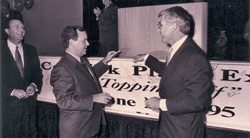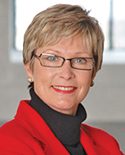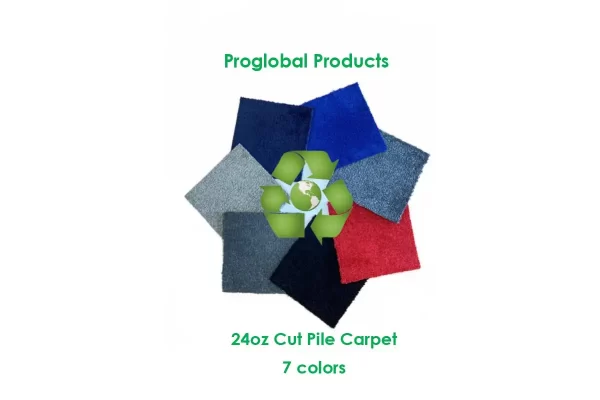The following collection of guest commentaries is the second of a two-part series spanning the exhibit industry’s transition from 2009 to 2010. Be sure to check out the first article in the December 2009 issue of Exhibit City News: bit.ly/Exhibit-Design-Update.

For this article, Exhibit City News asked four of our industry’s leading exhibit design and production executives to share their insight as to where the industry was in 2009 and where they expect it may go in 2010 and beyond. Each company spokesperson offered his or her perspective based on their firm’s niche in the market.
While each guest commentator has some differing view of the state of the industry, one overarching theme prevailed. The exhibit design and production segment of the exhibit/tradeshow industry is experiencing a historic paradigm shift. It forces exhibit houses to alter the way they develop and pitch business proposals, design exhibits and service clients before, during and after a show or event.
Today, exhibit houses are under pressure to alter their business strategies. These pressures are spawned by the current economic downturn and competitive influences. Clients are demanding more from their exhibit houses but wanting to pay less. Custom builds and refurbishing services are down while rental exhibits are increasingly popular. Storage, drayage and shipping costs continue to escalate, and general service contractors (GSCs) bundle services to make it more difficult to compete.
As Derse, Inc. President Adam Beckett stated so eloquently in the December article, “It is no longer business as usual. The industry model has changed and we will emerge from this recession with a different tradeshow landscape.”
Chris Kappes
President, Matrex
www.matrexhibits.com
Matrex builds brand communities through live environments that connect buyers and sellers. Founded in 1987, Matrex is a WBE-certified agency that serves a diverse Fortune 1000 client basefrom its headquarters in Addison, Ill.
“The industry is broken and needs reinvention,” Kappes said. “All you have to do is review the past eight years’ financial statements of the top 65 exhibit agencies, as the Exhibit Designer and Producers Association (EDPA) does each year, and you’ll find that the average net profit is 3 percent. How can you build a sustainable business model given the competitive environment, pricing and margin pressures, and emerging alternative media?”
Kappes suggested the following ways to combat this problem:
• You build alliances with other agencies – which Matrex is doing – to create economies of scale that drive down expenses while increasing opportunities to be competitive in new markets.
• You invent new products and services.
• You outsource more given the excess capacity in the industry.
• You are diligent about educating the buyers that tradeshows still represent the best dollar-for-dollar value versus other competing media.
“As an industry we’re facing the real danger of being commoditized; the end product quality is rarely scrutinized or recognized as a differentiator by most buyers,” Kappes added. “Instead, flat marketing budgets, the need to do more for less, and procurement involvement is driving decisions resulting in fewer true brand-centric exhibit experiences and more ‘same old’ presentations hitting the floor. It is projected that two buyers out of 10 will purchase new exhibits in 2010; the balance will be more rental and refurbish.
“Lastly, the industry is in an oligopoly state. Two giants, Freeman and EG/GES, control two-thirds of the overall market share for design/build/service. The danger in an oligopoly model is that the giants can and are leveraging their revenue stream as a strategic and tactical advantage versus the balance of the industry. Put another way, there are inherent advantages Freeman and EG/GES have as a general service (GSC) contractor that afford them a financial advantage (bundling of services) that independent design/build agencies simply don’t have.”
The EDPA defines bundling as “the practice of incorporating discounted and/or free services and products available exclusively to GSCs in their role as event general contractor when bidding for exhibit design/build and installation/dismantle and transport contracts.”
“Sadly, what the client gains in cost savings is lost in innovation resulting in homogeneous exhibit solutions that make tradeshows today not particularly exciting to see, engaging or immersive,” Kappes continued. “Tradeshows need to evolve to a place where sellers can more cost effectively tell their stories while buyers can attend and leave educated, engaged, and enthusiastic.
“The relevance of tradeshows in mature industries is declining, as there are more cost effective means of selling to a consolidated customer base. On the other hand, tradeshows in industries that are innovating or early in their business cycle are growing in importance since the buying base is large and diverse. We need to focus on emerging industries where margins are not under attack resulting in more marketing dollars being applied to expanding market share.
“Marketing budgets for 2010 are projected to be flat. Our focus should be on gaining a larger share of the marketing budget versus other media. Our competition is not other independent agencies (exhibit houses, etc.), but alternative media vying for the same marketing dollar. In tough times, the focus is on short-term results and tradeshows accelerate the sales cycle. If we are able to build this value proposition and ‘fish’ in the right industries, then the year should be very good. If we can’t build the value proposition then design/build opportunities will be fewer and we’ll all need to begin eating our tuna from a can.”
Matt Hubbard
President, Exhibit Works, a division of EWI Worldwide
www.ewiworldwide.com
EWI Worldwide is a global, live communications company that creates community between brands and customers. EWI Worldwide consists of three specialized service groups, each offering its own unique capabilities and resources: Exhibit Works, Interior Works and Studio Creative. EWI Worldwide supports a diverse group of clients across multiple industries.
“One trend that is evolving in our industry is the realignment of budgets away from many larger horizontal events into more vertically-aligned smaller events that provide an opportunity to get closer to key customers,” Hubbard said. “We [EWI Worldwide] see the opportunity for better optimization of live communications as a strategy. When clients understand that no event is an island, but rather an important opportunity to build strong and lasting relationships with key customers, we can develop an integration of marketing strategies around events to help break through the clutter and connect in more meaningful ways with their key customers. In addition, other community-building strategies like social media are being integrated more and more into tradeshow and event strategies.
“Today’s hyper-competitive marketplace is being driven by more competitors – traditional ad agencies and tradeshow general service contractors – competing for less work. Purchasing departments are also being mandated to reduce marketing costs. Lastly, a sense of desperation on the part of some exhibit houses is driving the entire marketplace down.
“Through an explosion of high-quality graphic and fabric solutions that provide the impact needed at reduced costs, brands are beginning to figure out how to integrate graphic solutions into programs without cheapening the brand. Our (EWI) Design-by-Rental program is experiencing a growing interest in hybrid rental solutions that provide a custom presence without the up-front capital costs.”
Thinking globally but acting locally may provide positive feedback.
“We are exploring with our clients ways to optimize the global event strategy to drive more effective communication and more efficient management of programs on a global scale, while ensuring that the message is localized effectively in critical international markets. We are also rethinking:
• The traditional exhibit house business model, including more openness to unbundling services from the carpenter hour.
• The tactical, execution-focused model that limited our ability to sit at the CMO (chief marketing officer) table.
• Diversification into other forms of live communications such as retail and events.”
Anita Mitzel President, GraphiColor Exhibits
President, GraphiColor Exhibits
www.graphicolor.com
GraphiColor Exhibits designs, builds, and rents custom exhibits in addition to offering portable displays, print graphics services, and a full range of account management services, including at-show client services. Founded by Anita and Don Mitzel in 1984, Graphicolor is located in the metropolitan Detroit community of Livonia, Mich.
“Like most exhibit companies, our clients are asking us to do more with less. Shows that we supplied exhibits and services for in 2009 were for the most part based on budgets established in 2008,” Mitzel said. “Currently, exhibitors are challenged to increase sales with fewer funds to work with for the upcoming tradeshow season. Our clients are shocked by how expensive drayage, rigging and other labor charges are, and they are frustrated because these services rarely come in at the original estimate and they really can’t forecast their show budgets. Just last week, one of our clients – fairly new to the world of show services – could not understand why we were unable to lock in a definite charge for their drayage, labor and related services, which his CEO needs in order to approve the budget. Exhibitors certainly have the right for these services to be more transparent.
“As exhibit designers and producers, we are expected to find every possible way to cut the costs of the booth and show services. However, when a client tells me that the general service contractor [GSC] for their upcoming show is offering to provide a booth and all the services [bundling] for less than half of the industry average, something just doesn’t sound right.
“I had heard the term ‘bundling’ for the first time several years ago at an EDPA conference. I understood it to mean that a show’s GSC was offering the exhibitors a full package of services for a reduced price, including those services which were exclusive to that GSC, such as materials handling, rigging and electric. This practice certainly poses an unfair advantage for the GSC when these exclusive services are a part of the ‘turn key’ offering.
“From what other clients have told me, some GSCs appear to be aggressively pursuing the exhibit houses’ current clients, whose contact information they can easily glean from the Exhibitor Appointed Contractor forms we are required to send them. In the meantime, once loyal clients may feel compelled to go with the GSC’s offer because of the perceived cost reduction. We feel reasonably sure that in the end, after paying unanticipated charges and getting less hands-on service than desired, our clients will return the following year. Nevertheless, given the challenges we’ve faced, especially in our region, it’s hard to take the hit.
“We live within a free enterprise system, and companies can offer any product or service they’d like and charge whatever they’d like as well. I just ask for fair play.”
Cindy Thompson
President, Transformit
www.transformit.com
Transformit designs, produces and installs ready-made and custom-made interior tension-fabric structures, with full service from concept to installation. Transformit structures are used in events, exhibits, retail, hospitality, museums and interior architecture.
“In 2009, exhibitors, designers and builders held off until the last moment to make spending commitments. Short lead times and constrained budgets raised demand for rentals. With our extensive inventory and seasoned installers, this was a bright spot in a tough year. I expect the trend to continue.
“For 2010, I see exhibitors choosing fewer shows and making more focused efforts at those shows. For custom builds, budgets and timelines will remain tight, but demand for unique design will only grow and successful execution is a must. To meet these requirements, some builders have abandoned the three-bid process when selecting fabric subcontractors, in favor of collaboration with one trusted supplier. The sole-source model assures delivery, saves time and resources for everyone, and liberates designers from the ‘dumbing down’ of tension fabric design. Sole-source will grow in 2010.
“Many companies are now making ‘flat’ fabric exhibits. While it is a cost-effective material substitute, even flat fabric requires expertise to look good. After walking the 2009 Exhibitor Show, my comment, as an artist and a fabricator, is that wrinkles are unacceptable, even on flat panels. Flat is in this year, and curves will always be with us. Either way, smooth is sexy.”
Although economic indictors are pointing toward a more promising 2010/2011 compared to 2008/2009, the consensus among the eight design professionals interviewed for this two-part article is that 2010 will not be business as usual. How their firms operated throughout the last decade will be very different in 2010 and beyond.
“Nobody knows how long it will take to recover from the current recession,” said Tom Lemery, President & CEO. Creatacor, Inc. “This year, requests for new exhibit builds were almost non-existent…I think we are going to see more of the same for the first six months of 2010 and possibly longer.
In order to survive in the near term, exhibit design firms will likely have to operate on smaller margins with fewer staffers while building business opportunities through strategic alliances and mergers while diversifying their service offerings and client base.
“I do believe that 2010 will be a better year than 2009,” said Jim Obermeyer, Partner, Reveal Exhibits. “I also believe corporate marketers will be challenging us to think more strategically, to come up with better ideas and to become more of a partner with them as they work toward growth again.”
Related Articles:
State of the Industry: Tradeshow freight carriers hopeful in 2010
State of the Industry: belief and hope for recovery
Aleta Walther is a Southern California-based marketing communications professional and freelance writer with several years experience as a corporate exhibit manager. Contact Aleta at aw@waltherstewart.com.




























